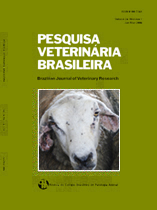 |
|
|
|
Year 2017 - Volume 37, Number 4
|

|
Comparison of two histopathological classifications with pattern of immunostaining KIT, evaluation of cell proliferation and the presence of mutations in c-KIT canine cutaneous mast cell tumors, 37(4):359-367
|
ABSTRACT.- Carvalho A.P.M., Carvalho E.C.Q., De Nardi A.B. & Silveira L.S. 2017. [Comparison of two histopathological classifications with pattern of immunostaining KIT, evaluation of cell proliferation and the presence of mutations in c-KIT canine cutaneous mast cell tumors.] Comparação de duas classificações histopatológicas com o padrão de imuno-marcação para KIT, a avaliação da proliferação celular e com a presença de mutações no c-KIT de mastocitomas cutâneos caninos. Pesquisa Veterinária Brasileira 37(4):359-367. Laboratório de Morfologia e Patologia Animal, Centro de Ciências e Tecnologias Agropecuárias, Universidade Estadual do Norte Fluminense Darcy Ribeiro, Campos dos Goytacazes, RJ 28013-602, Brazil. E-mail: annapmcarvalho@gmail.com
Histopathological classification is the method of choice to predict the biological behavior of mast cell tumor. Currently, the methods of Patnaik and Kiupel are used to divide them into degrees of malignancy. The objective of this study was to compare the two histological grades with clinical, immunohistochemical markers and the presence of mutations to evaluate the characteristics that are more related to each other and with the worst prognosis. Sixty-one dogs were evaluated, taking into account sex, race, age, tumor location, tumor grade by grades Patnaik and Kiupel, infiltration of eosinophils, pattern KIT, Ki-67 and the presence of mutation . The variables were correlated using the chi-square test, Fisher’s exact test, verisimilitude test and relative risk test. The older dogas were the most affected, while animals mixed breed, Boxer breeds, Labrador and Pinscher were those with greater predisposition to tumor development. The tumor location and age are associated with tumor grade. The tumors in the head, neck and genital area are 10 times more likely to be classified as high-grade (RR=10,667; 95% CI 1.909 to 59.615, p=0.004) grau and old-aged eight times more likely (RR=8.00, 95% CI 0.955 to 67.009, p=0.029). The grade II tumors and the low degree were the most frequent and the two histological scores showed very significant correlation (p<0.001). The concentration of eosinophilic infiltration showed no significant correlation with any of the histological scores. The standard KIT was dependent on tumor location (p=0.015), genital tumors, head and neck had 18 times more likely to have cytoplasmic pattern (RR=18.571, 95% CI 1.954 to 176.490, p=0.003), and Patnaik (p=0.001) and Kiupel (p<0.001) ratings. The high grade tumors are 36 times more likely to have cytoplasmic pattern (RR 36.00, 95% CI 4.35-297.948 p<0.001). The marking of the Ki-67 showed a dependence on the location (p=0.024). The presence of mutation in exon 11 of the juxtamembrane domain showed no association with any of the clinical variables of the histological scores, the concentration of eosinophils and KIT standard. The presence of the mutation was significantly correlated only to the Ki-67 (p=0, 010). The results suggest that the location is the clinical variable most related to prognosis and that only Kiupel classification associated with immunohistochemistry are efficient to assess tumor behavior. |
| |
|
|
| |
|
 |